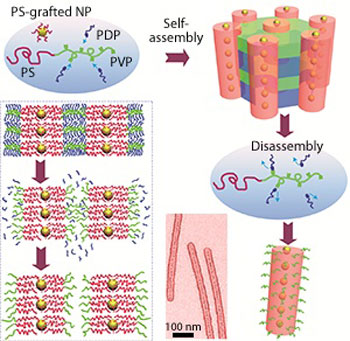| Aug 29, 2011 |
Micelle-wrapped nanoparticles for drug delivery
|
|
(Nanowerk News) Float a drop of fatty acid on water and the fat molecules spread out. The water-loving acid 'heads' sit on the surface and the water-hating fatty 'tails' stick up into the air. Curl the film up to form a sphere and you have a micelle. Making micelles is not new, but creating micelles with highly controlled surfaces containing functional nanoparticles is of current interest for drug delivery applications.
|
|
Jintao Zhu and colleagues from Huazhong University of Science & Technology in China have now come up with a simple, versatile method for creating micelles containing well-organized nanoparticles ("Encapsulation of Nanoparticles in Block Copolymer Micellar Aggregates by Directed Supramolecular Assembly").
|
 |
| Supramolecules formed from polystyrene (PS), poly(4-vinylpyridine) (PVP) and pentadecylphenol (PDP) dissolved in chloroform assemble around PS-grafted nanoparticles (NPs) to form a solid the when broken down affords hybrid worm-like micelles with controlled structures.
|
|
Orally administered medicines face a difficult journey on their way to the target organ in the body. They have to be soluble yet able to survive intact in a range of environments. Wrapping drugs in a protective shell to be released where needed may offer a solution to this problem. "We focused on constructing elongated worm-like micelles to encapsulate nanoparticles," says Zhu. "These micelle structures are particularly useful due to their relatively large volume and the ability to control the release profiles of the medicines they contain."
|
|
The traditional chemical approach for the preparation of micelles relies on the precipitation of molecules out of solution. Such methods, however, provide little control over the structures formed. Zhu's team took a different approach that involved building micelles layer-by-layer into a solid that could then be broken up to afford hybrid micelles with a well-defined structure (see image). By dissolving block copolymers of polystyrene and poly(4-vinylpyridine) in chloroform in the presence of pentadecylphenol, the researchers obtained supramolecules that self-assembled into larger structures. With the addition of polystyrene-grafted gold nanoparticles, the supramolecules formed worm-like assemblies around the nanoparticles as the solvent evaporated. These assemblies were then disassembled with alcohol, releasing the hybrid micelles. The spacing of the nanoparticles in the micelles could be controlled by altering the concentration of nanoparticles in solution during assembly.
|
|
The range of applications of the micelles is not limited to drug delivery, however. "These hybrids micelles could also find application in bioimaging, targeting and non-linear optics — the list is endless," says Zhu.
|

